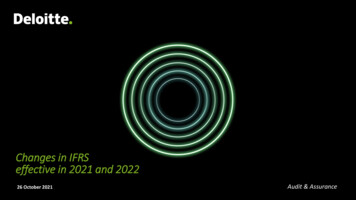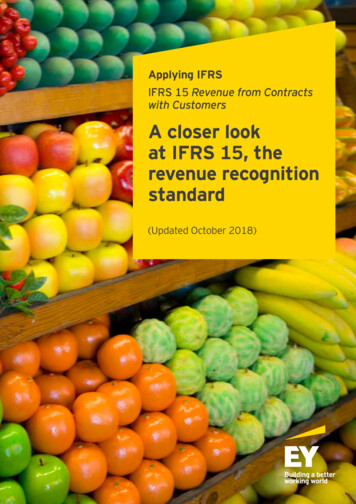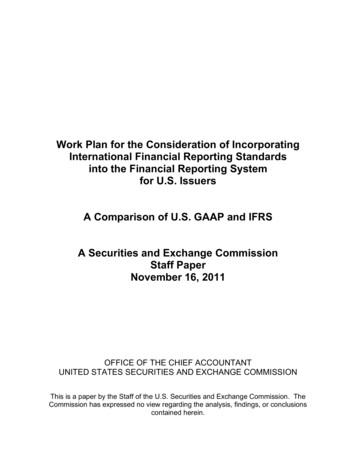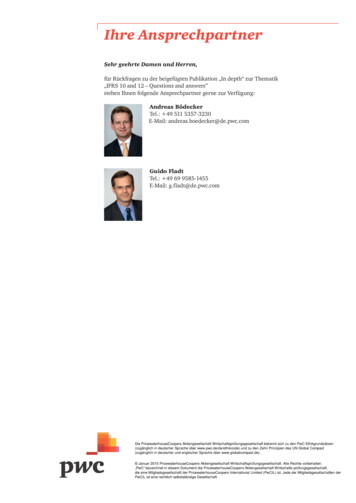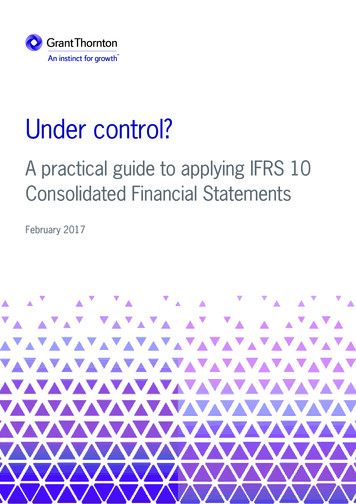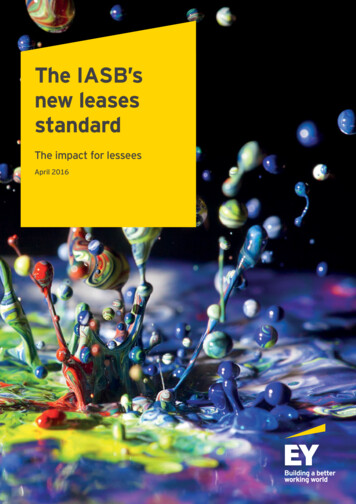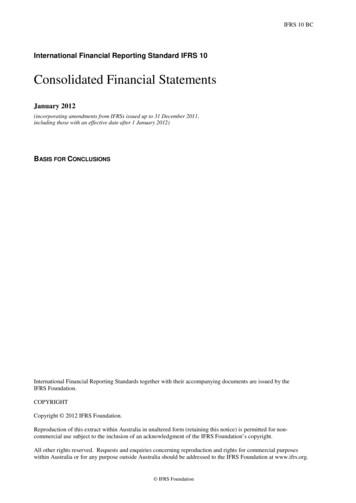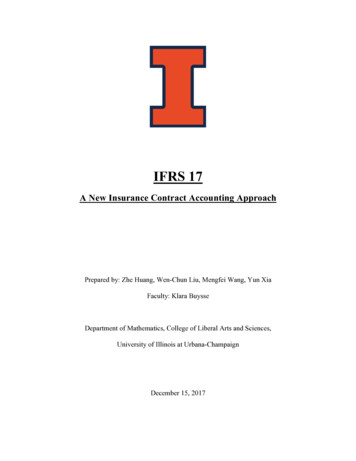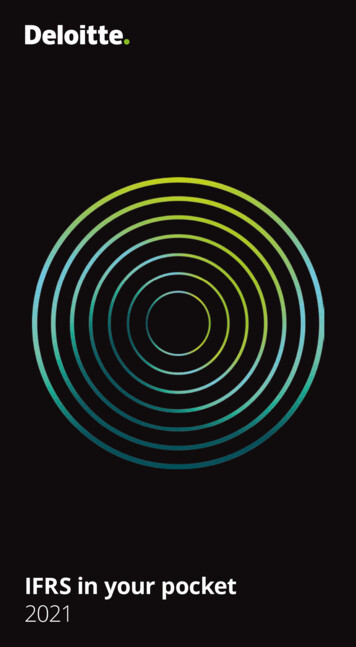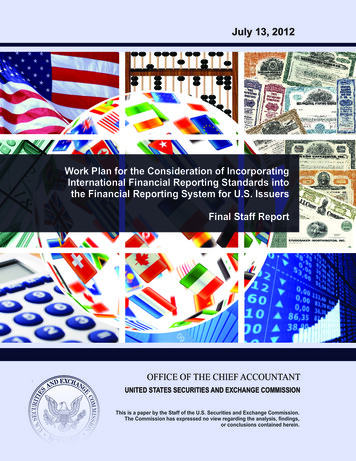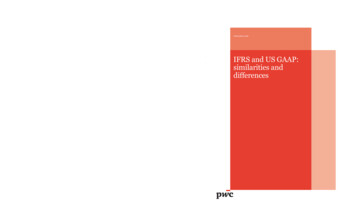
Transcription
www.pwc.com/usifrswww.pwc.comIFRS and US GAAP:similarities anddifferences 2016 PwC. All rights reserved. PwC refers to the US member firm, or one of its subsidiaries or affiliates, and may sometimes refer to the PwC network. Eachmember firm is a separate legal entity. Please see www.pwc.com/structure for further details.
This publication has been prepared for general informational purposes, and does not constituteprofessional advice on facts and circumstances specific to any person or entity. You should not act uponthe information contained in this publication without obtaining specific professional advice. Norepresentation or warranty (express or implied) is given as to the accuracy or completeness of theinformation contained in this publication. The information contained in this publication was not intended orwritten to be used, and cannot be used, for purposes of avoiding penalties or sanctions imposed by anygovernment or other regulatory body. PricewaterhouseCoopers LLP, its members, employees, and agentsshall not be responsible for any loss sustained by any person or entity that relies on the informationcontained in this publication. Certain aspects of this publication may be superseded as new guidance orinterpretations emerge. Financial statement preparers and other users of this publication are thereforecautioned to stay abreast of and carefully evaluate subsequent authoritative and interpretative guidance.The FASB Accounting Standards Codification material is copyrighted by the Financial AccountingFoundation, 401 Merritt 7, Norwalk, CT 06856, and is reproduced with permission.Copyright IFRS Foundation. All rights reserved. Reproduced by PricewaterhouseCoopers LLP with thepermission of IFRS Foundation. Reproduction and use rights are strictly limited. No permission granted tothird parties to reproduce or distribute. The International Accounting Standards Board and the IFRSFoundation do not accept responsibility for any loss caused by acting or refraining from acting in reliance onthe material in this publication, whether such loss is caused by negligence or otherwise.
PwC guide libraryOther titles in the PwC accounting and financial reporting guide series:PwC Bankruptcies and liquidations Business combinations and noncontrolling interests, global edition Consolidation and equity method of accounting Derivative instruments and hedging activities Fair value measurements, global edition Financial statement presentation Financing transactions Foreign currency Income taxes Leases Loans and investments Property, plant, equipment and other assets Revenue from contracts with customers, global edition Stock-based compensation Transfers and servicing of financial assets Utilities and power companiesi
AcknowledgmentsThe IFRS and US GAAP: similarities and differences publication represents theefforts and ideas of many individuals within PwC. The 2017 project leaders includeDavid Schmid, Ralph Martino, Brad Szalachowski, and Austin Schmitt.The following PwC people contributed to the content or served as technical reviewersof this publication:Nicole BermanCatherine BenjaminChris ChungShannon DetlingJustin FrenzelKatie HurleyMarie KlingShahram MehriAndreas OhlJay SeliberJennifer SpangScott TornbergSatoshi TsunodaJohn WayneShiri WertmanOther contributors include Richard Brown, Derek Carmichael, John Chan, JoannaDemetriou, Ilaria Evans, Philip Garcia, Tatiana Geykhman, Fiona Hackett, AkemiMiura, Ruth Preedy, and Katie Woods.iiPwC
PrefacePwC is pleased to offer this guide, IFRS and US GAAP: similarities and differences. Ithas been updated as of June 2017.This publication is designed to alert companies, investors, and other capital marketparticipants to the major differences between IFRS and US GAAP as they exist today,and to the timing and scope of accounting changes that the standard setting agendasof the IASB and FASB (collectively, the Boards) will bring.It would appear that the use of IFRS in the United States by public companies will notbe required for the foreseeable future. However, as discussed in Chapter 1, knowingboth accounting frameworks, being financially bilingual, is increasingly important forUS capital market participants.Each topical chapter consists of the following: A conceptual discussion of the current IFRS and US GAAP similarities anddifferences A detailed analysis of current differences between the frameworks, including anassessment of the impact of the differences Commentary and insight with respect to recent/proposed guidance In addition, this publication includes an overview of IFRS for small and mediumsized entities.This publication is not all-encompassing. It focuses on those differences that wegenerally consider to be the most significant or most common. When applying theindividual accounting frameworks, companies should consult all of the relevantaccounting standards and, where applicable, national law.References to US GAAP and IFRSDefinitions, full paragraphs, and excerpts from the FASB’s Accounting StandardsCodification and standards issued by the IASB are clearly designated within quotes inthe text. In some instances, guidance was cited with minor editorial modification toflow in the context of the PwC Guide. The remaining text is PwC’s original content.References to other chapters and sections in this guideWhen relevant, the discussion includes general and specific references to otherchapters of the guide that provide additional information. References to anotherchapter or particular section within a chapter are indicated by the abbreviation “SD”followed by the specific section number (e.g., SD 2.3.2 refers to section 2.3.2 inchapter 2 of this guide).PwCiii
Guidance dateThis guide has been updated and considers guidance under IFRS and US GAAP as ofJune 30, 2017. Additional updates may be made to keep pace with significantdevelopments. Users should ensure they are using the most recent edition available onCFOdirect (www.cfodirect.com) or Inform (www.pwcinform.com).Other informationThe appendices to this guide include a FASB/IASB project summary exhibit and asummary of significant changes from the previous edition.*****This guide has been prepared to support you in reviewing the differences betweenIFRS and US GAAP that we generally consider to be the most significant or mostcommon. It should be used in combination with a thorough analysis of the relevantfacts and circumstances, review of the authoritative accounting literature, andappropriate professional and technical advice.We hope you find the information and insights in this guide useful.Paul KeppleUS Chief AccountantivPwC
Table of contents1Importance of being financially bilingual1.1Overview .1-21.2IFRS and the SEC .1-21.3IFRS affects US businesses in multiple ways .1-31.3.1Mergers and acquisitions and capital-raising .1-31.3.2Non-US stakeholders .1-31.3.3Non-US subsidiaries .1-3Our point of view .1-31.42IFRS first-time adoption2.132-22.1.1What does IFRS 1 require? .2-22.1.2When to apply IFRS 1 .2-32.1.3The opening IFRS balance sheet .2-32.1.4Important takeaways .2-3Revenue recognition3.1Revenue recognition .3-23.2Converged revenue standard—post-adoption of the new standards .3-43.2.1Collectibility threshold .3-43.2.2Noncash consideration .3-43.2.3Licenses of intellectual property .3-53.2.4Practical expedients at transition and definition of completedcontract .3-63.2.5Shipping and handling .3-63.2.6Presentation of sales taxes .3-73.2.7Interim disclosure requirements .3-73.2.8Effective date .3-73.2.93.3PwCIFRS first-time adoption .Early adoption .3-83.2.10 Impairment loss reversal .3-83.2.10.1 Relief for nonpublic entities .3-8Historical revenue standards—pre-adoption of the new standards .3-93.3.1Revenue recognition—general .3-93.3.2Contingent consideration—general .3-103.3.3Multiple-element arrangements—general .3-113.3.4Multiple-element arrangements—contingencies .3-123.3.5Multiple-element arrangements—customer loyalty programs .3-123.3.6Multiple-element arrangements—loss on delivered elementonly .3-13v
Table of contents4vi3.3.7Sales of services—general .3-143.3.8Sales of services—right of refund .3-153.3.9Construction contracts .3-153.3.10 Sale of goods—continuous transfer .3-173.3.11Barter transactions .3-183.3.12Extended warranties .3-183.3.13Discounting of revenues .3-19Expense recognition—share-based payments4.1Expense recognition—share-based payments .4-24.2Scope .4-34.3Measurement of awards granted to employees by nonpubliccompanies .4-34.4Measurement of awards granted to nonemployees .4-44.5Classification of certain instruments as liabilities or equity .4-54.6Awards with conditions other than service, performance, ormarket conditions .4-54.7Awards with a performance target met after the requisite serviceperiod is completed .4-64.8Service-inception date, grant date, and requisite service .4-64.9Attribution—awards with service conditions and graded-vestingfeatures .4-64.10 Certain aspects of modification accounting .4-74.11Accounting for forfeitures .4-74.12Cash-settled awards with a performance condition .4-84.13Derived service period .4-84.14Tax withholding arrangements—impact to classification .4-94.15Accounting for income tax effects .4-94.16Recognition of social charges (e.g., payroll taxes) .4-104.17Valuation—Guidance on expected volatility andexpected term.4-114.18Employee stock purchase plans (ESPP) .4-114.19Group share-based payment transactions .4-124.20 Recent/proposed guidance .4-134.20.1 IASB amendments .4-134.20.1.1 Measurement of cash-settled share-basedpayment transactions that include anon-market performance condition .4-134.20.1.2 Classification of share-based payments settled netof tax withholdings.4-144.20.1.3 Modifications of a share-based payment transactionfrom cash-settled to equity-settled .4-144.20.2 FASB project .4-14PwC
Table of contents56Expense recognition—employee benefits5.1Expense recognition—employee benefits .5-25.2Expense recognition—gains/losses.5-45.3Expense recognition—prior service costs and credits .5-45.4Expense recognition—expected return on plan assets .5-55.5Income statement classification .5-65.6Capitalization of employee benefit costs .5-75.7Measurement date and frequency .5-75.8Substantive commitment to provide pension or other postretirementbenefits .5-85.9Defined benefit versus defined contribution plan classification .5-85.10Curtailments .5-95.11Settlements.5-105.12Asset ceiling .5-115.13Measurement of defined benefit obligation when both employersand employees contribute .5-115.14Plan asset valuation .5-125.15Discount rates .5-135.16Accounting for termination indemnities .5-135.17Deferred compensation arrangements—employment benefits .5-145.18Accounting for taxes .5-145.19Recent/proposed guidance .5-155.19.1 IASB exposure draft .5-155.19.1.1 Remeasurements at a significant event .5-155.19.1.2 Availability of refunds from a defined benefitplan managed by an independent trustee .5-15Assets—nonfinancial assets6.1Assets—nonfinancial assets .6-26.2Impairment of long-lived assets held for use—general .6-36.2.1Impairment of long-lived assets—cash flow estimates .6-46.2.2Impairment of long-lived assets—asset groupings .6-66.3Impairment of long-lived assets held for sale—general .6-66.4Carrying basis .6-76.5Internally developed intangibles .6-76.6Acquired research and development assets .6-86.7Indefinite-lived intangible assets—level of assessment forimpairment testing .6-96.7.1Indefinite-lived intangible assets—impairment testing .6-96.7.2Indefinite-lived intangible assets—impairment chargemeasurement .6-10Impairments of software costs to be sold, leased, orotherwise marketed .6-106.8PwCvii
Table of contents76.9Advertising costs .6-116.10Depreciation .6-126.11Overhaul costs .6-126.12Asset retirement obligations .6-126.13Borrowing costs .6-136.14Lease scope .6-146.15Lease classification—general .6-156.16Sale-leaseback arrangements .6-166.17Leases involving land and buildings .6-176.18Lease—other .6-186.19Distributions of nonmonetary assets to owners .6-206.20 Inventory costing .6-206.21Inventory measurement .6-216.22 Biological assets—fair value versus historical cost .6-216.23 Investment property .6-216.24 Recent/proposed guidance .6-226.24.1 Leases—Joint Project of the FASB and IASB .6-226.24.1.1 Scope .6-236.24.1.2 Separating components of a contract and contractcombinations .6-246.24.1.3 Lessee accounting .6-246.24.1.4 Lessor accounting .6-266.24.1.5 Lease re-assessments and modifications .6-266.24.1.6 Sublease transactions .6-276.24.1.7 Sale and leaseback transactions .6-276.24.1.8 Presentation and disclosure .6-276.24.1.9 Transition .6-286.24.2 IASB completes comprehensive review of the IFRS forSMEs .6-286.24.3 FASB improvements to the derecognition of nonfinancialassets .6-28Assets—financial assets7.1Assets—financial assets .7-27.2Available-for-sale financial assets—fair value versus cost of unlistedequity instruments .7-3Available-for-sale debt financial assets—foreign exchange gains/losseson debt instruments .7-4Effective interest rates—expected versus contractual cash flows .7-47.4.1Effective interest rates—changes in expectations .7-57.5Eligibility for fair value option .7-67.6Fair value option for equity-method investments .7-67.7Fair value of investments in investment company entities .7-77.37.4viiiPwC
Table of contents7.8Loans and receivables.7-77.9Reclassifications .7-87.10Impairment principles—available-for-sale debt securities .7-97.11Impairment principles—held-to-maturity debt instruments .7-107.12Impairment of available-for-sale equity instruments .7-117.13Losses on available-for-sale equity securities subsequent to initialimpairment recognition .7-127.14Impairments—measurement and reversal of losses .7-127.15Derecognition.7-137.16Recent/proposed guidance .7-157.16.1FASB and IASB financial instruments projects .7-157.16.1.1FASB and IASB impairment projects .7-157.16.1.2 FASB Accounting Standards Update 2016-13,Financial Instruments—Credit Losses(Topic 326). .7-167.16.1.3IFRS 9, Financial Instruments—ExpectedCredit Losses .7-18FASB Accounting Standard Update 2016-01,Financial Instruments—Overall: Recognitionand Measurement of Financial Assets andFinancial Liabilities .7-19IFRS 9, Financial Instruments—Classificationand measurement .7-217.16.2 Premium Amortization on purchased callable debt securities .7-227.16.3 FASB Proposed Accounting Standards Update:Accounting for Financial Instruments and Revisions to theAccounting for Derivative Instruments and Hedging Activitiesand IASB IFRS 9 Financial Instruments, Hedge accountingand amendments to IFRS 9, IFRS 7 and IAS 39 ities—taxes .8-28.2Hybrid taxes .8-28.3Tax base of an asset or a liability .8-38.4Initial recognition of an asset or a liability.8-48.5Recognition of deferred tax assets .8-48.6Deferred taxes on investments in subsidiaries, joint ventures,and equity investees .8-5Recognition of deferred taxes where the local currency is not thefunctional currency .8-68.8Uncertain tax positions .8-78.9Special deductions, investment tax credits, and tax holidays .8-88.10 Intercompany transactions .8-98.11Change in tax laws and rates .8-98.12Tax rate on undistributed earnings of a subsidiary .8-108.7PwCix
Table of contents8.13Presentation .8-108.14Intraperiod allocation .8-128.15Disclosures .8-138.16Interim reporting .8-138.17Separate financial statements .8-148.18 Share-based payment arrangements .8-148.19Recent/proposed guidance .8-148.19.1FASB’s ongoing project .8-148.19.2Intra-entity asset transfers .8-158.19.3Balance sheet classification of deferred taxes .8-158.19.4New FASB and IASB guidance on the recognition ofdeferred tax assets arising from unrealized losses ondebt investments .8-15Uncertainty over income tax treatments her .9-29.2Recognition of provisions .9-29.3Measurement of provisions.9-39.4Discounting of provisions .9-49.5Restructuring provisions (excluding business combinations) .9-59.6Onerous contracts.9-59.7Accounting for government grants .9-69.8Reimbursement and contingent assets .9-79.9Levies .9-710 Financial liabilities and equity10.1Financial liabilities and equity .10-210.2Contingent settlement provisions .10-310.3Derivative on own shares—fixed-for-fixed versus indexed to issuer’sown shares.10-410.4 Derivatives on own shares—settlement models.10-510.5Written put option on the issuer’s own shares .10-610.6 Compound instruments that are not convertible instruments (that donot contain equity conversion features) .10-710.7Convertible instruments (compound instruments that contain equityconversion features) .10-710.8 Puttable shares/redeemable upon liquidation .10-810.9x10.8.1Puttable shares .10-810.8.2Redeemable upon liquidation .10-9Initial measurement of a liability with a related party .10-1010.10 Effective-interest-rate calculation .10-10PwC
Table of contents10.11 Modification or exchange of debt instruments and convertibledebt instruments .10-1110.12 Transaction costs (also known as debt issue costs) .10-1310.13 Eligibility for fair value option .10-1510.14 Nonrecourse liabilities .10-1510.15 Recent/proposed guidance .10-1610.15.1IFRS 9, Financial Instruments .10-1610.15.2 FASB Accounting Standards Update 2016-01, FinancialInstruments—Overall (Subtopic 825-10): Recognition andMeasurement of Financial Assets and Financial Liabilities .10-1610.15.2.1Fair value option .10-1710.15.3 FASB Accounting Standards Update No. 2016-04,Recognition of Breakage for Certain Prepa
accounting standards and, where applicable, national law. References to US GAAP and IFRS Definitions, full paragraphs, and excerpts from the FASB’s Accounting Standards Codification and standards issued by the IASB are clearly designated within quotes in the text. In some instances
